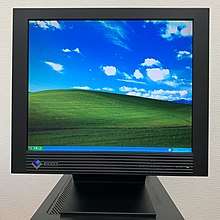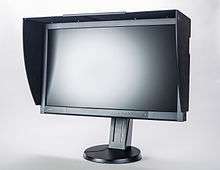Eizo
EIZO Corporation (EIZO株式会社, EIZO Kabushiki-gaisha) is a Japanese visual technology company, founded in March 1968, who manufacturers high-end computer displays. It has its headquarters in Hakusan, Ishikawa Prefecture.[1]
 | |
| Public KK | |
| Traded as | TYO: 6737 |
| ISIN | JP3651080008 |
| Industry | Computer |
| Founded | Hakui, Ishikawa, Japan (March 1968) |
| Headquarters | 153 Shimokashiwano, Hakusan, Ishikawa 924-8566, Japan |
Key people | Yoshitaka Jitsumori (President and CEO) |
| Products |
|
| Revenue | |
Number of employees | 1,675 (consolidated, as of March 31, 2014) |
| Subsidiaries | Irem |
| Website | www.eizo.com |
| Footnotes / references [1][2][3][4][5] | |
Eizo, pronounced AY-ZO, means "image" or "vision" in Japanese.[6] EIZO develops and manufactures high-end display products and other solutions for markets such as business, healthcare, graphics, air traffic control, and maritime.[7]
Name
The name "Eizo" comes from the Japanese word meaning "image" (映像 eizō).
History
The company was founded as Hakui Electronic Corporation in Hakui, Ishikawa, Japan, in 1968; it initially manufactured televisions. In March 1973, it became Nanao Corporation. In 1976, it began manufacture of industrial monitors, and in 1981 started making PC monitors.
In 1980, the company acquired video game developer and publisher Irem Corporation.[8]
Hitec Associates Ltd was founded in 1984 as a sales subsidiary of Nanao specifically for the European market.[3]
In 1985, "EIZO" was launched as a brand of Hitec Associates in Europe. In the same period, parent company Nanao founded Nanao USA in the United States to launch products in that region under the "Nanao" brand as in Japan.
In January 1990, Hitec Associates Ltd was renamed EIZO Corporation.
In May 1990, the company moved its headquarters to Mattō, Ishikawa (now Hakusan).
In 1996, the "EIZO" brand replaced the "Nanao" brand in Japan and the United States, although Nanao remained the corporate name of the company in Japan. In the United States, Nanao USA was renamed Eizo Nanao Technologies[9]
In 1997, Irem Software Engineering Inc. (a subsidiary company that replaces Irem Corporation) was founded.[8]
In 1999, Nanao Corporation and EIZO Corporation merged to become EIZO Nanao Corporation, which in 2013 changed its name to simply EIZO Corporation.[3]
Products


Eizo's products portfolio includes:
- Business LCD Monitors (FlexScan Series)
- Graphics monitors (ColorEdge Series)
- Arcade machine monitors
- Touch panel, IP Decoders and Industrial monitors (DuraVision Series)
- Medical display systems (RadiForce Series)
- OR Area camera and display systems (CuratOR Series)
- Home entertainment monitors (FORIS Series)
- Air traffic control monitors (Raptor Series)
- Accessories
References and footnotes
- "Corporate Profile". Eizo Corporation. Retrieved August 18, 2014.
- "Financial Highlight". Eizo Corporation. Retrieved August 18, 2014.
- "Company History". Eizo Corporation. Retrieved August 18, 2014.
- "Company Profile". Nikkei Asian Review. Nikkei Inc. Retrieved September 5, 2017.
- "Financial Highlights". Bloomberg Businessweek. Retrieved August 18, 2014.
- "Nanao USA Corporation changes name to EIZO Nanao Technologies Inc". Business Wire. March 29, 1996. Retrieved September 26, 2018.
- "Contributing to the Betterment of Society as a Visual Technology Company". EIZO Corporation. Retrieved September 26, 2018.
- "沿革 | EIZO株式会社". www.eizo.co.jp. Retrieved 2019-06-06.
- "EIZO Inc.: Private Company Information - Bloomberg". www.bloomberg.com. Retrieved 2019-06-06.
External links
- Official website (in English)
- Official website (in Japanese)
- Official website (Global)